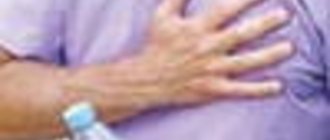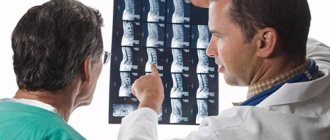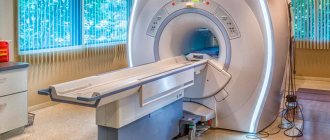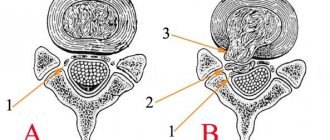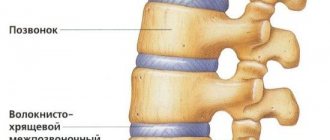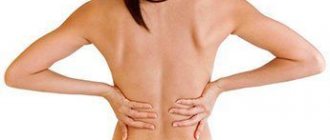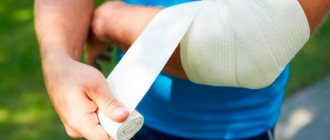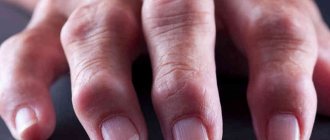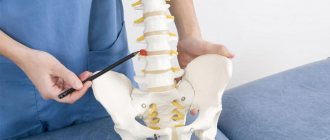A normal spine, when viewed from behind, should be straight. When viewing the spine from the side, the spine has natural curves in the neck, thoracic region and lumbar region. In the lumbar and cervical region, the normal curvature of the spine ( lordosis ) is caused by differences in thickness between the anterior and posterior portions of the intervertebral disc. This shape of the spine positions the head correctly in relation to the pelvis, and the natural curves perform a certain shock-absorbing function, distributing load vectors and providing the most optimal biomechanics when performing movements.
With hyperlordosis, there is an excessive increase in forward arching of the spine. Hyperlordosis can occur in the cervical region or lumbar region. In the clinical picture, hyperlordosis in the lumbar spine is of greater importance, which leads to disruption of the pelvic tilt and displacement of load vectors not only on the vertebrae, but also on the hip joints. With the patient lying on his stomach, on a hard surface, hyperlordosis will appear as a concave space in the lower back. Excessive lordosis may increase during puberty and sometimes becomes apparent only after the age of 20.
But in addition to hyperlordosis, hypolordosis can also occur, in which the back is more straightened, which leads to stretching of the intervertebral disc posteriorly and compression of the disc in the front, which can, in turn, lead to a narrowing of the holes through which the nerves pass, causing their compression.
Symptoms and types of spinal lordosis
In the field of treatment of the disease, it is usually divided into the following types:
- hypolordosis: the physiological curve of the lumbar spine is smoothed or straightened. There may be pain and limited mobility in the lower back, the patient’s gait changes, and after prolonged standing or sitting on a chair, back pain appears;
- hyperlordosis: the curvature of the spine in the lower back is too pronounced. The abdomen protrudes forward, the pelvis is retracted back. Mobility in the lower back is limited, and pain occurs periodically.
Causes
There are a number of diseases and conditions that can lead to the development of hyperlordosis:
- Pregnancy
- Osteoporosis is a disease in which the vertebrae become fragile and break easily (compression fractures).
- Obesity or being overweight.
- Kyphosis. A condition characterized by an abnormally rounded upper back.
- Discitis. Inflammation of the disc space between the bones of the spine, most often caused by infection
- Functional lordosis of minors
- Achondroplasia is a genetic disease of bone and cartilage tissue, which is inherited in an autosomal dominant manner and is characterized by impaired formation of cartilage tissue and, as a rule, is accompanied by excessive lordosis
- Spondylolisthesis: This is a condition in which a vertebra becomes displaced in relation to the underlying one. This condition can be either congenital or the result of injury. Listhesis can lead to lordosis and is one of its symptoms.
- Poor Posture: Poor posture over time can place stress on the lumbar region, which can eventually lead to lordosis. This problem is quite common among professional football players.
- Anomalies of the spine
- Neuromuscular diseases: Diseases such as myelomeningocele, cerebral palsy, muscular dystrophy, spinal muscular atrophy and arthrogryposis are more likely to present with hyperlordosis than other diseases. Hyperlordosis often occurs when the thigh muscles are weak or shortened.
- Problems in the hip. Typically, hip problems are caused by tightness of the hip flexors and can be caused by poor exercise technique, poor posture, and hyperkyphosis (common in dancers). These problems in the hip can also cause lordosis.
- Tumors and infections
Our methods of treating spinal lordosis
Kinesitherapy
from 1500 rub.
Osteopathy
from 1000 rub.
Manual therapy
from 2500 rub.
Prevention
There are many ways to prevent lordosis. Their use will help you not only eliminate posture problems from your life, but also improve your health in general. First, try to eat right and avoid becoming overweight. Sports activities aimed at strengthening the back muscles and an active lifestyle will help get rid of many posture problems. Regularly monitor how you hold your back and purchase an orthopedic mattress. Following these simple rules will help you and your loved ones avoid a diagnosis called Lordosis.
Treatment of lordosis in adults
Traditional methods of treating pathology with the help of corsets and limiting the mobility of the spine only worsen the situation. Symptomatic treatment of lordosis relieves pain, but does not solve the problem. Surgical correction can remove a visible defect, but will not eliminate the cause of the pathology. In addition, after the intervention, the blood supply to the muscles and spine deteriorates, and this leads to a worsening of the situation.
Since the reason lies in the weakening of the muscular corset and the articular-ligamentous apparatus of the spinal column, it is necessary to act on these links. To treat lordosis in adults, we use kinesitherapy. It is based on the healing effect of movement, which activates the body's own reserves and helps strengthen the back muscles in a natural way.
The development of a treatment program for spinal lordosis begins with myofascial diagnostics, which helps to identify weakened and spasmodic muscles. Testing on multifunctional machines helps determine the optimal load and range of motion. Classes are supervised by an instructor and an experienced kinesiotherapist.
Benefits of kinesitherapy:
- safety (anti-gravity and decompression simulators eliminate axial load on the joints and spine);
- versatility (it is possible to treat lordosis in adults of different ages and levels of physical fitness);
- efficiency (bending is normalized by strengthening the muscle corset, the trophism of the vertebral structures is improved, and they become less susceptible to deformation).
Treatment of spinal lordosis with kinesitherapy means not only beautiful posture and confident gait, but also excellent well-being.
Sign up for a consultation: 8 (495) 803-27-45.
Diagnostics
Diagnosis of lordosis (hyperlordosis), as a rule, does not present any particular difficulties, and a preliminary diagnosis is made on the basis of a medical history and examination, on the basis of which it is possible to assess both the degree of lordosis and the presence of concomitant spinal deformities (kyphosis or scoliosis), an assessment is carried out range of motion, muscle strength. In addition, it is necessary to assess the neurological status (reflex activity, signs of sensory impairment, muscle strength). Radiography is primarily used for diagnosis, and in most cases allows one to determine the presence of changes and assess the severity of the deformity. More complex research methods, such as CT or MRI or ENMG are necessary in cases where there are neurological symptoms or other somatic diseases that may cause the development of lordosis. Laboratory research methods are necessary in case of suspected inflammatory processes, infections, tumors. Scintigraphy is also used when it is necessary to differentiate changes in tissues from tumors or infections.
Cost of treatment
| Services list | Price |
| Initial consultation with a kinesiotherapist | 1600 |
| Interim consultation with a kinesiotherapist (test session) | for free |
| Session with a kinesiotherapist (1 patient) | 3900 |
| Session with a kinesiotherapist (2 patients) | 3900 |
| Group lesson with kinesiotherapist | 2200 |
| Individual lessons with a personal trainer | 2700 |
| Subscription for 1 month of training in the gym on simulators | 10000 |
| Subscription for 6 months of gym training | 45000 |
Contact us
Call now
8 (495) 803-27-45
Make an appointment through our service
Make an appointment
Fighting tactics
A degenerative change such as spinal flattening cannot be cured with pills. First of all, it is necessary to find the cause of such processes in the body. If you are overweight, a balanced diet is prescribed; if you are pregnant, you will be prescribed a corrective bandage. In general, a comprehensive approach is taken to eliminating symptoms and slowing down curvature processes.
Chondroprotectors are the basis for the treatment of any problems with the musculoskeletal system
Drug therapy
It is aimed at relieving pain and relieving the inflammatory process. The doctor selects appropriate medications individually, taking into account the patient’s age, his general health, the presence of concomitant chronic diseases, and other things.
The following medications are usually prescribed:
- Non-steroidal anti-inflammatory drugs (Diclofenac, Ibuprofen). They relieve pain, relieve swelling in the lower back, and are prescribed as needed.
- Painkillers (“Analgin”, “Ketonol”). If the pain is severe and does not go away after taking the pills, then a lidocaine blockade is prescribed. It allows you to stop the unpleasant syndrome for a long time and relieve you from unpleasant sensations for a long time.
- Chondroprotectors (“Donna”, “Teraflex”). With their help, the process of regeneration of cartilage tissue is accelerated. You can’t do without them if the problem is an intervertebral hernia
- Vitamin complexes. It is especially important that the composition contains group B, calcium, magnesium and other trace elements.
Drugs alone will not be enough to fight effectively, so along with them, the doctor prescribes exercises, visits to a chiropractor and physiotherapy. Only this approach allows you to get a good result and slow down negative processes in the spine, eliminating possible complications.
No ads 2
Physiotherapeutic activities
Physiotherapeutic procedures relieve static disturbances in the lumbar region as the disease develops, so they are prescribed in combination with exercises. The following techniques are of great benefit:
- Massage. It is carried out only during the period of remission by medical personnel with a sufficient level of qualifications. Helps normalize blood circulation and improve metabolic processes in the damaged area.
- Acupuncture. Eastern methods have long been famous for their effectiveness. The impact on acupuncture points helps to activate the restoration of natural processes that normalize the condition and restore the health of soft and bone tissues.
- Magnetotherapy. It is not prescribed to everyone, as it has a number of contraindications. But, like the others, it is aimed at improving the patient’s condition and restoring health.
All techniques require the session to be carried out only by qualified personnel, otherwise there is a risk of aggravating the problem. In addition to them, the patient is also recommended to take up swimming or yoga to strengthen the muscular frame of the back. Doctors usually prescribe exercise therapy when there is no compression of the cerebral roots.
[node:field_similarlink]
Exercises for flattened lordosis
A smoothed curve in the lower back can be well treated with exercise therapy exercises. The complex itself is developed by a specialist. It is he who sets the number of approaches, duration of the lesson and its intensity. Here are some examples of how patients with this pathology are trained.
- The process always begins with preparation, warming up all muscle groups to properly prepare them for the upcoming load.
- Take a gymnastics stick and raise your arms high above your head. Gently bend in all directions, controlling your breathing and your own sensations. There should be no pain or discomfort.
- Lie on your back, bend your knees and try to pull them towards your chest as far as the stretch allows. Return to starting position.
- Without changing position, pull your knees to your chest, and then move them slightly to the side. Repeat the approach for the other side.
- Get on your knees and focus on your palms. Bend your spine upward, holding this position for 7 seconds. Then return to the starting position.
The session ends with light stretching to prevent injury to the warmed muscles. If you feel severe pain, discomfort, or dizziness during the process, stop training. This usually happens if the execution technique is violated, thereby causing an exacerbation.
Therapeutic gymnastics is carried out only under the supervision of medical personnel
No ads 3
